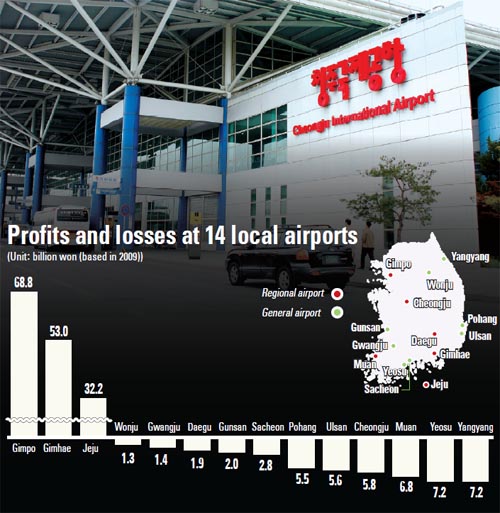Airports run on empty, bleeding billions in won

An hour later, an air of silence filled the airport once again.
Only two or three flights to Bangkok, Hong Kong or Osaka, Japan, are scheduled certain days at Cheongju. On Tuesdays and Thursdays, when no flights are scheduled, there’s no sign of life except for a couple of administrators. In 2009, the airport ran a deficit of 5.8 billion won ($5.1 million).
Korea Airports Corporation (KAC), which manages 14 Korean airports, announced on Feb. 11 that it will sell Cheongju Airport, which has been suffering from a long-term deficit, to a private party - the first time this has ever happened in the country. Incheon International Airport, which is a profit-making airport, is managed separately from KAC airports.
“Two organizations have bid on the airport,” said Bae Yong-su, vice president of the KAC, which plans to complete the transaction by the end of June. And even as the government proceeds with plans to build a 10 trillion won airport in the southeastern part of the country, 11 of the 14 airports that KAC operates are losing money, KAC said.
Only three - Gimpo, Jeju and Gimhae - are profitable. The other 11 airports are in the red from anywhere between 1 billion won and 7 billion won each. These airports barely manage to operate, only surviving because of subsidizing investments from the three airports that run surpluses.
“All of the local airports suffering from deficits would collapse if subsidies were cut off,” said Lee Gang-bin, a professor in the trade department at Sangji University.
In 2009, Gimpo, Jeju and Gimhae recorded a profit of 154.1 billion won, the KAC said. The other airports recorded lost a total of 48 billion won.
And despite the three airports running a surplus, they are all aging and in need of renovations. The Ministry of Land, Transport and Maritime Affairs plans to spend 20 billion won to expand Jeju and improve runways at Cheongju and Yeosu.
Some believe the financial troubles stem from there being too many airports, and politics have also played a role.
“Powerful politicians and heads of local governments have pushed construction of local airports that don’t really have economic power,” said a ministry official.
And in recent years, every time the administration has changed, one or two local airports have been built. During the Kim Young-sam administration, for instance, Yangyang airport opened, followed by Uljin airport during the Kim Dae-jung administration.
There is also the issue of competition, in part due to the development of high-speed trains and numerous expressways throughout the country.
“Demand won’t rise automatically by establishing an airport,” said Park Je-hee, a marketing team leader at the KAC.
And some of the 11 airports have even shut down for normal passenger operations, and in the process, they have wasted hundreds of billions of won. Also, some projects were halted, while others failed to open despite being built.
Yangyang airport is, in fact, a ghost airport. Construction began in 1997 and it opened in 2004 at a cost of 350 billion won. However, since October 2008, there have been no regular flights. Eleven KAC employees are stationed there to administer the building.
Ulsan’s airport shares a similar story. A 140 billion won airport in Uljin, North Gyeongsang, it was built during the Kim Dae-jung administration. It was never used. Last year, it was turned into a pilot training center after another investment of 5 billion won.
And the failure of Ulsan came with advanced warning.
“In 2001, the Korea Transport Institute forecasted that there would be only 50 users a day,” said an official at the institute.
By Chang Chung-hoon, Yim Seung-hye [enational@joongang.co.kr]
Related Korean Article [중앙일보]
영남 신공항 논란으로 본 지방공항 14곳 현주소
공항 11곳 ‘세금 블랙홀’… 결국 청주공항 매각한다
만성 적자 공항 운영권 첫 매각
11일 오후 2시쯤 청주국제공항에 오사카(大阪)에서 출발한 대한항공 KE736편이 도착했다. 149석짜리 항공기에서 내린 승객은 31명. 여행객들은 한 시간 남짓 만에 터미널을 빠져나갔고 공항은 다시 적막감에 휩싸였다. 청주공항엔 하루 두세 편의 오사카·홍콩·방콕행 항공편만 운항한다. 항공편이 전혀 없는 화요일과 목요일에는 공항 관리직원이 아니면 인기척을 찾아보기 어려울 정도다. 청주공항은 2009년 58억원의 적자를 냈다.
전국 14개 지방공항을 관리하는 한국공항공사는 11일 지방공항 중 처음으로 만성 적자에 시달리는 청주공항을 민간에 매각하겠다고 발표했다. 배용수 한국공항공사 부사장은 “청주공항 민영화를 위한 운영권 매각 입찰에 2개 업체가 참여했다”고 말했다. 한국공항공사는 이 두 곳 중 한 곳을 우선협상자로 선정한 뒤 6월 말까지 모든 매각작업을 완료하겠다는 계획이다. 한국공항공사가 공항의 운영권을 민간에 매각하는 것은 이번이 처음이다. 한국공항공사는 정부의 공기업 선진화 계획에 맞춰 2009년 청주공항의 터미널과 계류장, 주차장 등 민항시설의 운영권을 민간에 넘기기로 결정했었다. 적자에 허덕이는 지방공항의 활성화를 위해서다.
지방공항의 적자는 청주공항만의 문제가 아니다. 전국 14개 공항 중 수익을 내는 곳은 김포·제주·김해 세 곳뿐이다. 나머지 11개 공항은 매년 10억~70억원대의 적자 행진을 벌인다. 그런데도 명맥을 유지하고 있는 것은 …
http://news.joins.com/article/142/5045142.html?ctg=










with the Korea JoongAng Daily
To write comments, please log in to one of the accounts.
Standards Board Policy (0/250자)